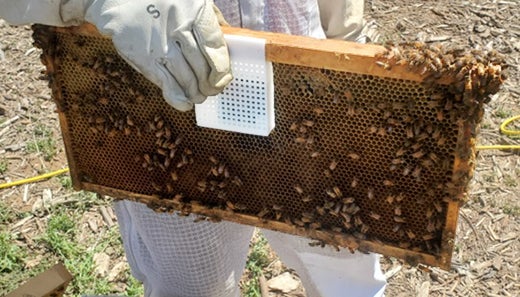2025-02-21 カリフォルニア大学リバーサイド校(UCR)

A low-cost heat sensor on a beehive frame (UCR photo)
<関連情報>
- https://news.ucr.edu/articles/2025/02/21/beehive-sensors-offer-hope-saving-honeybee-colonies
- https://dl.acm.org/doi/10.1145/3719014
EBV+を用いたミツバチ時系列の原理的マイニング、予測、モニタリング Principled Mining, Forecasting and Monitoring of Honeybee Time Series with EBV+
Mst. Shamima Hossain, Christos Faloutsos, Boris Baer, Hyoseung Kim, Vassilis J. Tsotras
ACM Transactions on Knowledge Discovery from Data Published:21 February 2025
DOI:https://doi.org/10.1145/3719014
Abstract
Honeybees, as natural crop pollinators, play a significant role in biodiversity and food production for human civilization. Bees actively regulate hive temperature (homeostasis) to maintain a colony’s proper functionality. Deviations from usual thermoregulation behavior due to external stressors (e.g., extreme environmental temperature, parasites, pesticide exposure, etc.) indicate an impending colony collapse. Anticipating such threats by forecasting hive temperature and finding changes in temperature patterns would allow beekeepers to take early preventive measures and avoid critical issues. In that case, how can we model bees’ thermoregulation behavior for an interpretable and effective hive monitoring system?
In this paper, we propose the principled EBV + (Electronic Bee-Veterinarian plus) method based on the thermal diffusion equation and a novel ‘sigmoid’ feedback-loop (P) controller for analyzing hive health with the following properties: (i) it is effective on multiple, real-world beehive time sequences (recorded and streaming), (ii) it is explainable with only a few parameters (e.g., hive health factor) that beekeepers can easily quantify and trust, (iii) it issues proactive alerts to beekeepers before any potential issue affecting homeostasis becomes detrimental, and (iv) it is scalable with a time complexity of O(t) for reconstructing and O(t×m) for finding cuts of a sequence with C time-ticks. Experimental results on multiple real-world time sequences showcase the potential and practical feasibility of EBV+. Our method yields accurate forecasting (up to 72% improvement in RMSE) with up to 600 times fewer parameters compared to baselines (ARX, seasonal ARX, Holt-winters, and DeepAR), as well as detects discontinuities and raises alerts that coincide with domain experts’ opinions. Moreover, EBV+ is scalable and fast, taking less than 1 minute on a stock laptop to reconstruct two months of sensor data.



